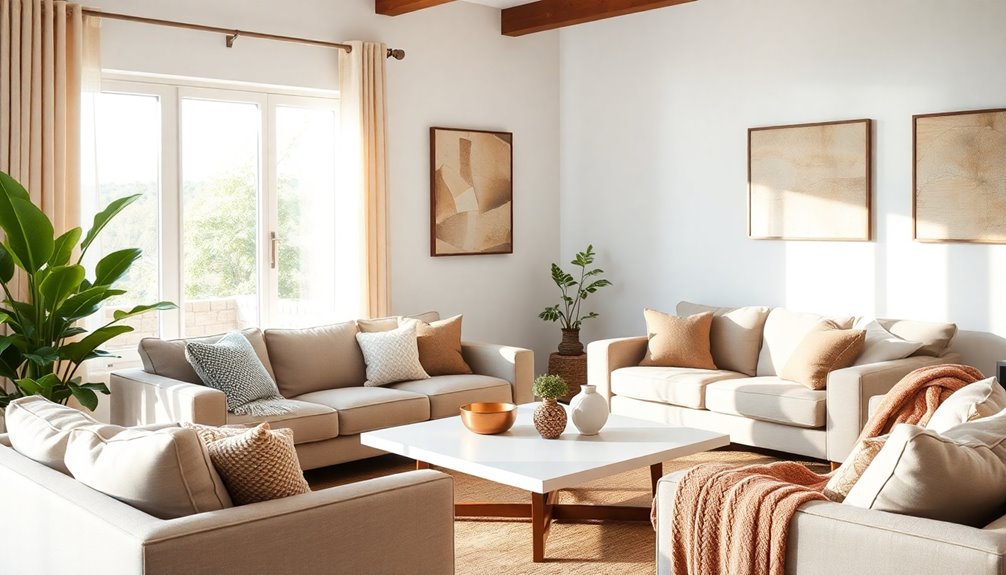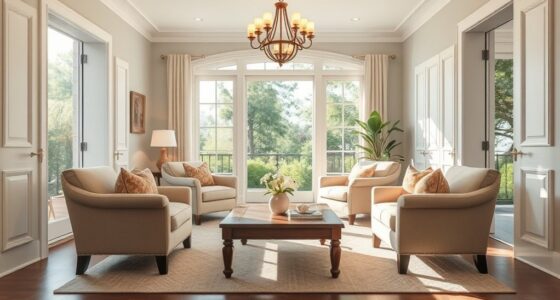When designing for contemporary elderly living, focus on accessibility and comfort. Prioritize wider pathways and round furniture to enhance mobility. Use natural lighting and calming colors to create inviting spaces. Integrate technology like smart devices for safety and communication. Flexible furniture arrangements allow for various activities while personal touches and sustainable materials enhance the overall atmosphere. Discover how to transform living environments that support independence and well-being, leading to a more fulfilling lifestyle for seniors.
Key Takeaways
- Prioritize functional and accessible spaces with wider pathways and round furniture to accommodate mobility aids like walkers and wheelchairs.
- Incorporate personal mementos and custom artwork to create a comfortable, home-like atmosphere that reflects residents' identities and histories.
- Maximize natural light and use calming color palettes to enhance mood and promote relaxation in living spaces.
- Integrate technology such as smart speakers and telehealth services for improved communication, safety, and healthcare accessibility.
- Embrace nature by including indoor gardens and flexible arrangements to foster social interaction and promote mental well-being.
Functional and Accessible Spaces
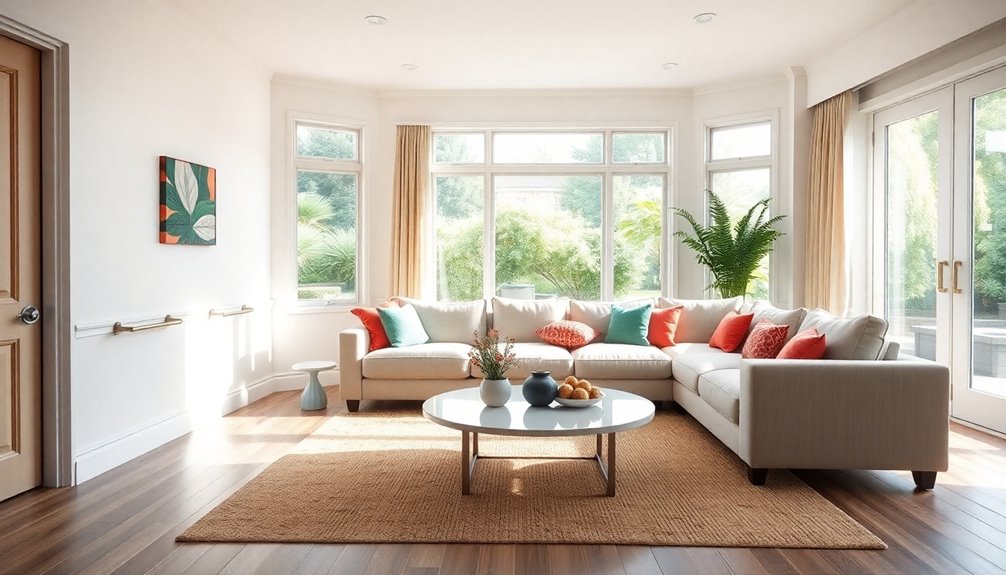
When designing for elderly living, prioritizing functional and accessible spaces is essential to enhance safety and comfort.
You'll want to focus on creating wider pathways and using round furniture to make navigation easier for residents using walkers or wheelchairs. Avoid decorative rugs to minimize tripping hazards, guaranteeing a safer environment.
Selecting functional furniture options not only maximizes space but also allows residents to move freely and comfortably throughout their living areas.
Additionally, integrating accessible storage solutions guarantees that frequently used items are within easy reach. This promotes independence and convenience, making daily activities smoother.
Thoughtful layout designs will create open spaces that encourage social interaction while meeting the functional needs of older adults.
Comfortable and Home-like Atmosphere

Creating functional and accessible spaces sets the foundation for a comfortable and home-like atmosphere in elderly living.
To enhance this ambiance, incorporate personal mementos and decor items that reflect the residents' lives. Displaying family photos on walls and counters not only personalizes the environment but also strengthens emotional connections with loved ones. Maintaining familiar objects and heirlooms can ease the adjustment and boost comfort levels. Additionally, having a well-designed space that promotes aging in place can significantly enhance the overall living experience for seniors. Moreover, emphasizing the importance of holistic living can contribute to a more fulfilling lifestyle in these environments.
Use soft lighting and cozy textiles to create inviting areas that promote relaxation. Additionally, designing communal spaces like lounges or reading nooks encourages social interaction, fostering a sense of community. Incorporating cozy textiles can further enhance the inviting atmosphere, making spaces feel warm and welcoming.
These elements are essential in senior living interior design, helping residents feel truly at home in their new surroundings.
Use of Natural Lighting and Colors

When you maximize natural light in elderly living spaces, you create a vibrant atmosphere that lifts moods and boosts alertness. Pairing this light with calming color palettes, like soft blues and greens, promotes relaxation, while brighter colors in dining areas can stimulate appetite and encourage social interaction. Additionally, incorporating air quality considerations can further enhance the living environment, ensuring that the air remains clean and fresh for optimal health. The use of energy-efficient water systems can also contribute to a sustainable and comfortable living space, reflecting a growing trend towards eco-consciousness in design. Furthermore, integrating heat pumps into these spaces can significantly reduce energy consumption and improve comfort throughout the year.
Maximizing Natural Light
- Position furniture wisely: Arrange seating to avoid blocking windows, allowing light to flow freely. Regular cleaning of windows can also significantly improve the amount of light that enters, enhancing overall brightness and indoor air quality.
- Choose sheer window treatments: Open windows and use light fabrics to increase sunlight while providing ventilation. Incorporating plants can further purify the air, contributing to a healthier living environment.
- Incorporate brighter colors: Use vibrant hues in dining areas to stimulate appetite and make mealtimes more enjoyable. A clean and organized space can enhance the impact of color choices, creating a more inviting atmosphere.
Utilizing these strategies not only brightens senior living spaces but also creates a more inviting atmosphere, contributing positively to residents' moods and health. Additionally, the incorporation of natural elements can further enhance the tranquility and comfort of the space.
Embrace natural light for a brighter, more uplifting home!
Calming Color Palettes
Three key elements—color, light, and nature—can transform elderly living spaces into serene retreats. Calming color palettes, like soft blues and nature-inspired greens, help reduce anxiety and promote relaxation. These soothing tones, combined with abundant natural light, can greatly enhance the quality of life for older adults. By strategically placing windows and furniture to maximize sunlight, you create a mood-boosting environment. Additionally, creating a comfortable living space can alleviate stress for surviving family members during end of life planning. Incorporating functional layouts that consider mobility can further enhance accessibility and comfort for seniors. Regularly trimming a cat's nails can also be beneficial when pets are part of the household, reducing the risk of accidental scratches on delicate surfaces.
| Color Scheme | Benefits |
|---|---|
| Soft Blues | Reduces anxiety |
| Nature Greens | Promotes relaxation |
| Warm Neutrals | Enhances comfort |
| Light Pastels | Increases feelings of safety |
Incorporating these elements not only lowers stress but also fosters a comforting atmosphere for seniors.
Bright Dining Areas
Creating a bright dining area not only enhances the aesthetic appeal but also greatly impacts the well-being of seniors.
In senior living communities, these spaces can foster a sense of connection and comfort. To achieve this, consider these key elements:
- Vibrant Colors: Use yellows and oranges to stimulate appetite and create an inviting atmosphere.
- Natural Light: Incorporate large windows and open layouts to maximize sunlight, reducing the need for artificial lighting. Ensuring adequate sleep in a bright environment can greatly improve overall mood and energy levels.
- Balanced Palette: Pair calming colors like soft greens and blues with brighter accents for a soothing yet energizing environment.
Additionally, incorporating cozy spaces can further enhance the comfort and usability of dining areas for seniors.
Making Life Easier
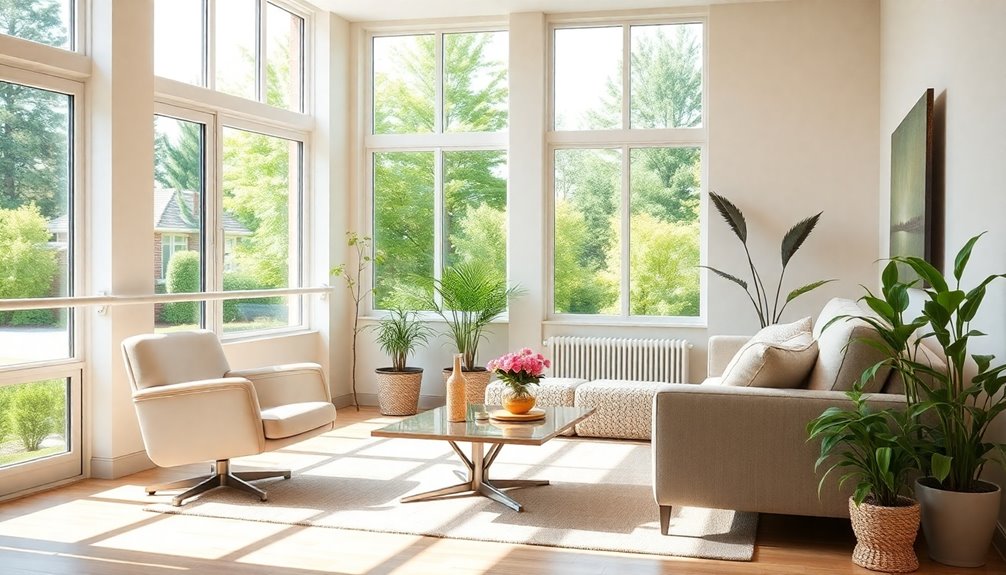
To make life easier for elderly residents, it's essential to design spaces that prioritize accessibility and convenience. In senior living facilities, consider placing frequently used items within easy reach to minimize bending or stretching.
Replace traditional round knobs with lever handles, making doors and cabinets simpler to operate for those with limited hand strength. Position sturdy furniture strategically to provide support as residents navigate their environment.
Integrate design elements like grab bars and non-slip flooring to enhance safety and accessibility, reducing the risk of falls. Finally, focus on a streamlined layout that minimizes clutter and allows for larger pathways, facilitating movement for those using walkers or wheelchairs.
These thoughtful design choices can greatly improve daily living for elderly residents.
Integration of Technology and Digital Tools
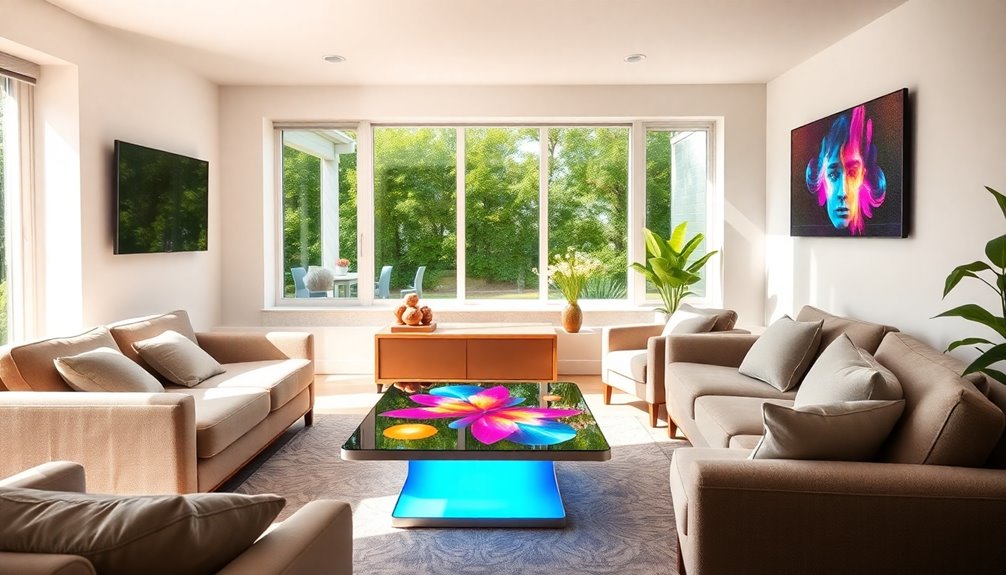
Modern technology plays an essential role in enhancing the quality of life for seniors, making it easier for them to stay connected and engaged.
The integration of technology in your senior living community can transform daily experiences and promote independence.
Here are three key innovations to evaluate:
- Wearable devices with location tracking guarantee safety while allowing seniors to maintain their independence.
- Smart speakers facilitate hands-free communication, helping seniors stay in touch with family and friends effortlessly.
- Telehealth services provide easy access to medical consultations, reducing the need for transportation and improving healthcare accessibility. Additionally, utilizing advanced care planning can ensure that seniors receive personalized medical attention tailored to their needs.
Incorporation of Nature and Outdoor Spaces

Bringing nature indoors with features like indoor gardens can greatly enhance your well-being and create a peaceful atmosphere.
Additionally, outdoor gathering areas offer a perfect setting for socializing and relaxation, helping you stay active and connected with others.
Together, these elements can transform your living space into a rejuvenating environment.
Indoor Gardens Benefits
While you may not think of indoor gardens as a necessity, their benefits for elderly living spaces are profound.
Integrating indoor gardens into your senior living design trends can create a nurturing environment that fosters well-being. Here are three key advantages:
- Enhanced Air Quality: Indoor plants improve air quality, promoting better respiratory health. Additionally, the use of air purifiers can further enhance the cleanliness of indoor air, ensuring a healthier living environment.
- Reduced Stress: Studies show greenery can lower stress and anxiety levels, enriching mental well-being.
- Encouraged Activity: Engaging in light gardening tasks encourages physical activity, aiding mobility and coordination.
Incorporating indoor gardens not only beautifies your space but also fosters cognitive function and creates a calming atmosphere. Additionally, natural remedies such as indoor plants can be beneficial in promoting overall health, making them a great addition to senior living spaces.
It's a simple yet effective way to enhance the quality of life for residents.
Outdoor Gathering Areas
Indoor gardens create a calming atmosphere, but enhancing outdoor gathering areas takes senior living design to the next level.
These spaces encourage a sense of community by providing comfortable seating and communal fire pits, where you can engage with neighbors and make new friends.
Incorporating nature through gardens and landscaped areas not only beautifies the environment but also promotes mental well-being and relaxation.
Walking paths and exercise zones invite you to stay active, while shaded pergolas and canopies guarantee comfort in the sun.
Imagine enjoying al fresco dining, savoring meals in a natural setting that elevates your dining experience.
Outdoor gathering areas truly enrich your quality of life while fostering connections in a warm, inviting atmosphere.
Flexible Furniture Arrangements for Various Purposes

Flexible furniture arrangements can transform a living space into a multifunctional haven for seniors, adapting easily to their changing needs.
By incorporating flexible layouts and modular furniture, you can create a versatile environment that promotes comfort and functionality.
Here are three key elements to reflect on:
- Moveable partitions: These can separate spaces for personal reflection or group activities without permanent changes.
- Lightweight fixtures: Foldable tables and stackable chairs allow for quick changes between dining, crafting, or exercise areas.
- Round furniture: Utilizing round pieces encourages open layouts, enhancing movement and social interaction while reducing accident risks.
With these strategies, you can guarantee your living space remains accessible and enjoyable, catering to various activities and preferences.
Personalization of Living Spaces

Creating a personalized living space can greatly enhance a senior's sense of ownership and comfort. By incorporating personalization into your home, you reflect your unique tastes and preferences, making it truly yours.
Adding personal mementos, family photos, and heirloom pieces fosters emotional connections, transforming a new environment into a familiar haven. Custom artwork and textiles can create a unique atmosphere that resonates with your identity and history, promoting well-being.
Memory boxes and curated essentials help you preserve sentimental items while keeping your space clutter-free, benefiting mental health.
Don't forget digital frames displaying family memories; they add a modern touch to your decor, allowing you to update your living space effortlessly.
Embracing community design principles can further enhance this personalization journey.
Multi-purpose Common Areas for Socialization
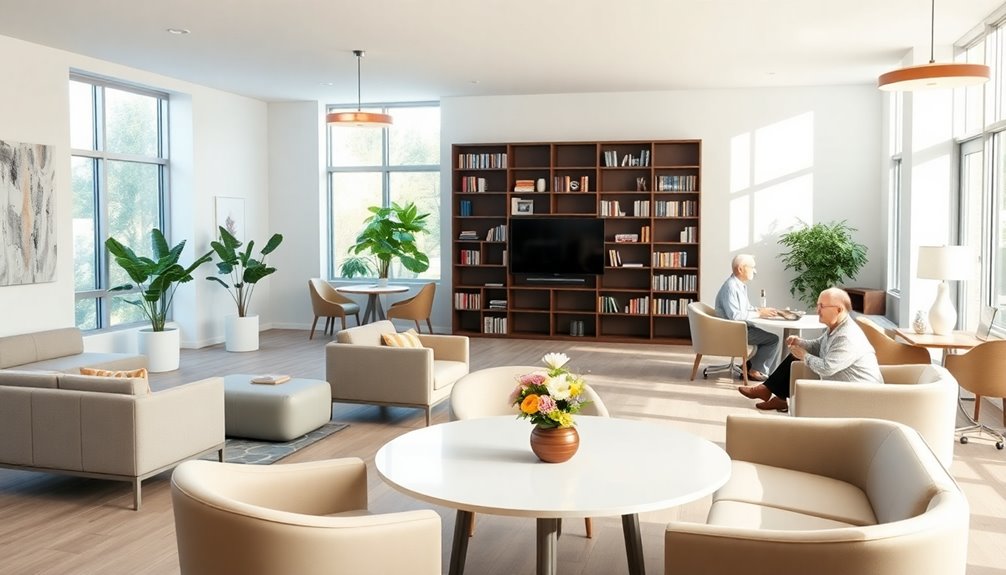
While you may cherish your personal space, multi-purpose common areas play an essential role in fostering social connections among residents.
These multi-purpose rooms are designed for various activities, enhancing your sense of community. Here's how they benefit you:
- Flexible Spaces: With modular seating and movable partitions, you can easily adapt the environment for group exercises, art classes, or social events.
- Technological Integration: Smart screens and audio-visual equipment allow for engaging presentations, movie nights, or virtual gatherings, bringing everyone together.
- Inviting Atmosphere: Natural light and calming color schemes create relaxing environments, while outdoor terraces encourage al fresco dining and socializing.
Sustainable and Eco-friendly Design Choices
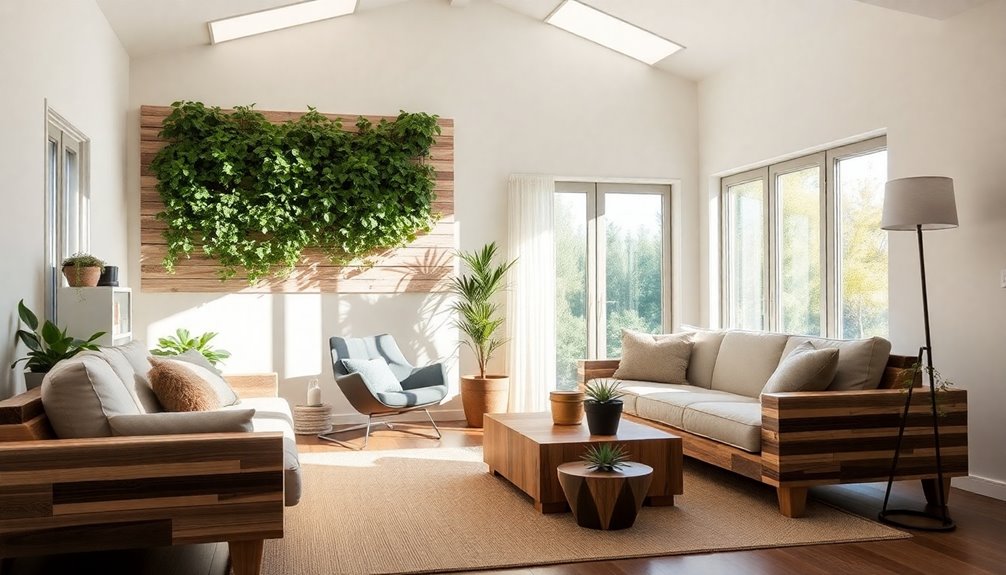
When designing spaces for elderly living, you can make sustainable choices that really matter.
By incorporating energy-efficient lighting solutions and using recycled materials, you not only enhance indoor air quality but also help the environment.
These eco-friendly design elements create a healthier, more cost-effective living space for everyone.
Energy-efficient Lighting Solutions
Energy-efficient lighting solutions play an essential role in enhancing the comfort and safety of elderly living spaces.
By integrating these sustainable and eco-friendly options, you can create a more inviting environment while reducing energy costs.
Here are three effective strategies:
- LED Bulbs: They consume up to 75% less energy than traditional bulbs, lowering electricity bills and environmental impact.
- Daylighting Strategies: Incorporate skylights and large windows to boost natural light, improving mood and well-being for residents.
- Smart Lighting Systems: Use programmable lights that adjust brightness, helping regulate circadian rhythms for better sleep quality.
Incorporating these energy-efficient lighting solutions not only promotes safety but also qualifies facilities for green building certifications, fostering a sustainable community identity.
Recycled Material Use
Recycled materials are transforming the world of senior living design, offering stylish and eco-friendly options that resonate with both sustainability and aesthetics. By incorporating reclaimed wood, repurposed metals, and recycled textiles, you can create unique spaces that reflect character while reducing waste.
Here's a quick overview of the benefits:
| Material Type | Benefits | Cost Comparison |
|---|---|---|
| Reclaimed Wood | Unique aesthetics, sustainable | Lower than new wood |
| Repurposed Metals | Durable, eco-friendly | Cost-effective |
| Recycled Textiles | Non-toxic finishes, healthier homes | Often cheaper |
Using recycled materials not only enhances your facility's appeal but also attracts environmentally conscious residents, making it a win-win for everyone involved.
Indoor Air Quality
Creating inviting spaces with recycled materials enhances the aesthetic appeal of elderly living facilities, but it's equally important to focus on indoor air quality.
By prioritizing clean air, you'll create a healthier environment for residents in assisted living. Here are three effective strategies:
- Incorporate Indoor Plants: Use snake plants and peace lilies to filter out toxins and boost humidity.
- Choose Low-VOC Products: Opt for low-VOC paints and finishes to minimize harmful emissions.
- Upgrade HVAC Systems: Implement energy-efficient systems with advanced filtration to eliminate allergens and pollutants.
Regular maintenance of ventilation systems and air purifiers also plays a significant role in optimizing indoor air quality, ensuring a comfortable and safe atmosphere for seniors.
Frequently Asked Questions
What Is the 70/30 Rule in Interior Design?
The 70/30 rule in interior design suggests you dedicate 70% of your space to functional elements and 30% to decorative features.
It helps you maintain a balance between usability and aesthetics. By prioritizing essential furniture and pathways, you create a practical layout that promotes comfort and accessibility.
The decorative portion allows you to add personal touches, making your space feel like home while ensuring it remains safe and easy to navigate.
What Are the Senior Living Design Trends for 2024?
You might think senior living design trends can't be sophisticated, but that's far from the truth.
In 2024, you'll see wellness-focused interiors featuring soothing colors and elements like indoor gardens for better air quality.
Technology's integrated with smart home features, and flexible layouts allow for easy adjustments.
Nature-infused designs promote calmness, while personalized spaces let residents showcase their unique style, creating a truly inviting and homely atmosphere.
What Is the Most Desirable Home Design for Aging in Place?
The most desirable home design for aging in place focuses on accessibility and comfort.
You'll want wider pathways and round furniture to accommodate mobility aids, ensuring safety.
Maximizing natural light with well-positioned windows and soothing colors enhances your living space's warmth.
Integrating technology, like smart home devices, can support your independence.
Personal touches, such as family photos, help create a comforting atmosphere, while wellness features like indoor gardens promote both emotional and physical well-being.
What Is the Most Timeless Interior Design?
Think of a classic novel that never goes out of style; that's what timeless interior design feels like.
You'll want to focus on neutral color palettes that create a serene vibe, while durable materials like hardwood and natural stone guarantee longevity.
Functional furniture, such as round tables, enhances safety and accessibility.
Conclusion
Incorporating these 10 interior design trends can truly enhance contemporary elderly living. Did you know that 90% of seniors prefer to age in place? By creating functional, accessible, and personalized spaces, you not only promote comfort but also foster independence and happiness. Embracing technology and sustainable choices further enriches their living experience. So, why not take these trends to heart and transform your loved one's home into a vibrant, supportive environment they'll cherish?
